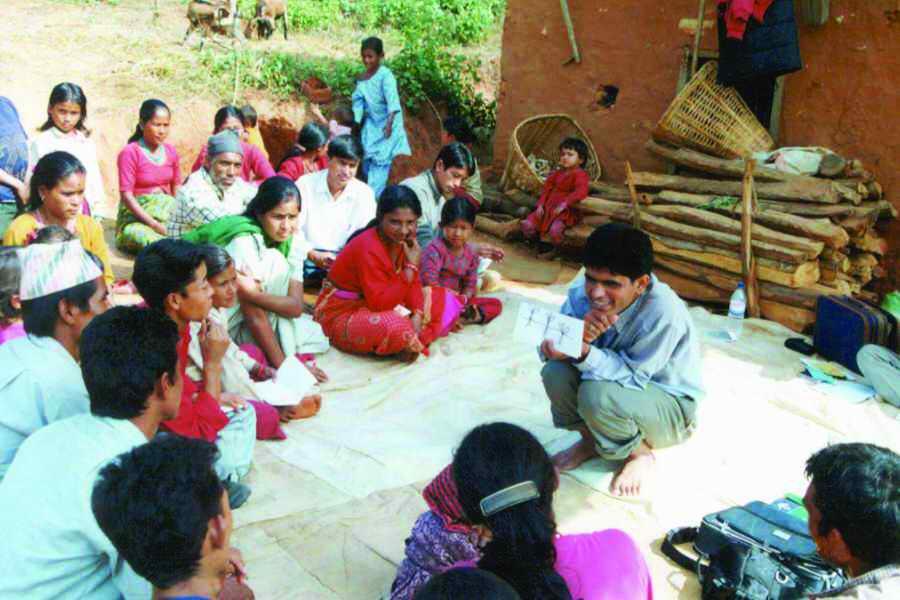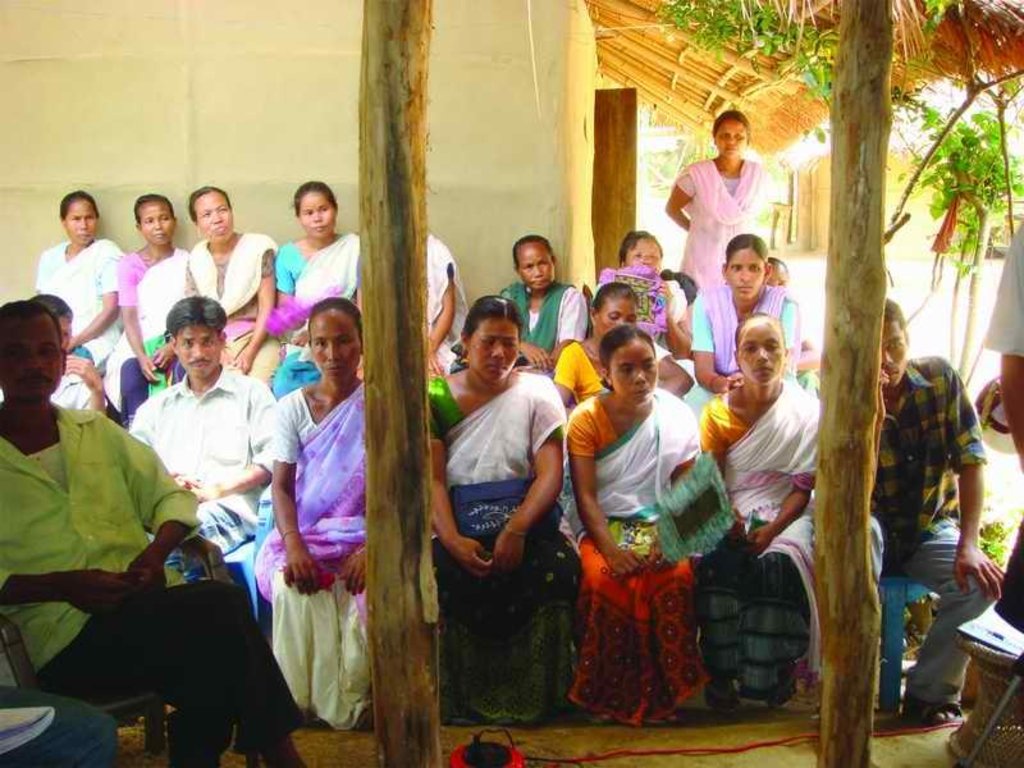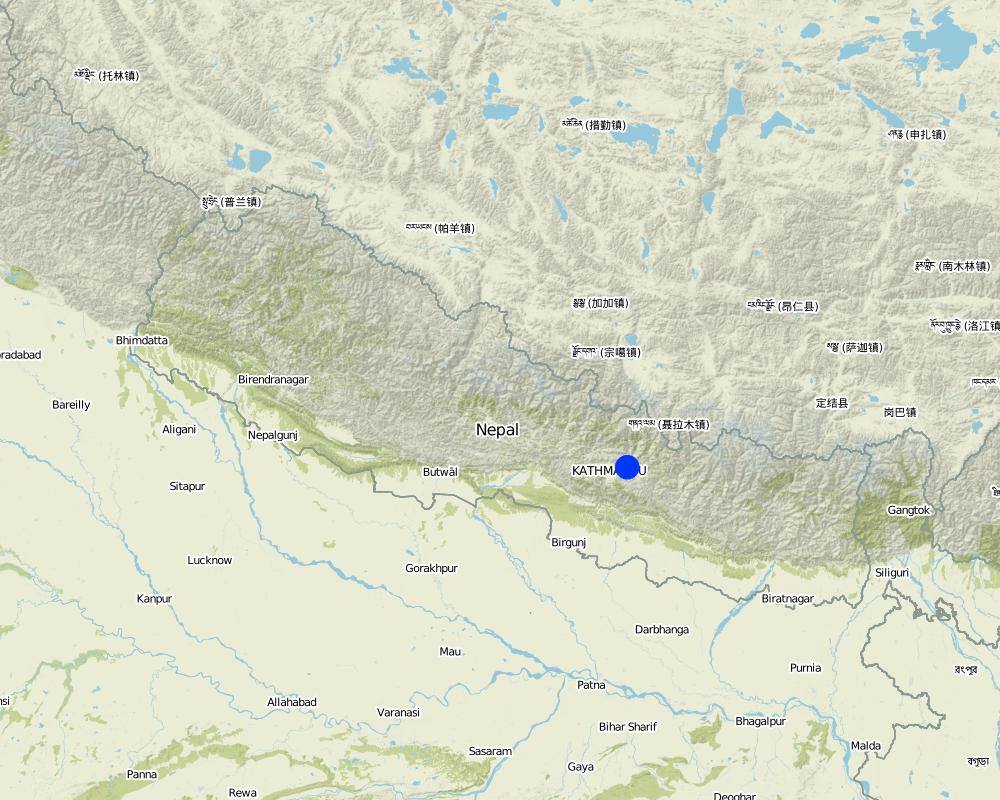Improving terraces with farmers [Nepal]
- Criação:
- Atualização:
- Compilador/a: Madhav Dhakal
- Editor: –
- Revisor: Laura Ebneter
Kisansangai gara sudhar (Nepali)
approaches_2549 - Nepal
Veja as seções
Expandir tudo Recolher tudo1. Informação geral
1.2 Detalhes do contato das pessoas capacitadas e instituições envolvidas na avaliação e documentação da abordagem
Especialista em GST:
Nome da(s) instituição(ões) que facilitou(ram) a documentação/avaliação da Abordagem (se relevante)
ICIMOD International Centre for Integrated Mountain Development (ICIMOD) - Nepal1.3 Condições em relação ao uso da informação documentada através de WOCAT
O/a compilador/a e a(s) pessoa(s) capacitada(s) aceitam as condições relativas ao uso de dados documentados através da WOCAT:
Sim
2. Descrição da abordagem de GST
2.1 Descrição curta da abordagem
Participatory action research with multiple stakeholders for the demonstration and extension of improved rainfed hill terraces in Nepal
2.2 Descrição detalhada da abordagem
Descrição detalhada da abordagem:
The traditional farming practices employed on steep sloping land in Kubinde village in Nepal's midhills led to soil and water erosion and low crop and fodder yields. The People and Resource Dynamics in Mountain Watersheds of the Hindu Kush- Himalayas Project (PARDYP) started work in 2001, with a small group of farmers from this village (who were also members of the local forest user group) and the Department of Soil Conservation and Watershed Management to identify and test an integrated approach for addressing these constraints. The approach taken was an improved hill terrace for rainfed conditions consisting of structural and vegetative measures. The aim was to demonstrate and test the technologies' potential for overcoming constraints related to farming sloping agricultural land. The specific objectives were, in association with the local farmers, to design a technology that solved soi erosion problems on sloping agricultural lands whilst at the same time increasing the land's nutrient conservation and production capacity. The local line agency office of the Department of Soil Conservation and Watershed Management was involved in developing the technology to make use of their experiences and to come up with a validated technology that the department could use in its own programmes.
Before implementing the terrace improvement work in Kubinde village, a terrace improvement committee was formed made up of local farmers. The awareness activities began in January 2001. Committee members were trained on subwatershed management and were taken to the International Centre for Integrated Mountain Development’s (ICIMOD) Demonstration and Training Centre at Godavari and another ICIMOD site to show them potential soil and water conservation technologies including improved terraces. After the technologies were implemented, a number of farmer exchange, interaction and monitoring programmes were held to assess the technology and to promote it. Indicators were developed for monitoring the activity.
About half of the costs were covered by the participating farmers and the rest by PARDYP. The other incentives were training and extension, allowances for participants, national expert honoraria, and training material such as audio-visual facilities. These were all provided by PARDYP with the help of the line agency.
2.3 Fotos da abordagem
2.5 País/região/locais onde a abordagem foi aplicada
País:
Nepal
Especificação adicional de localização:
kavre Palanchok/ Kubinde village, Jhikhu Khola watershed
Map
×2.6 Datas de início e término da abordagem
Ano de término (caso a abordagem não seja mais aplicada):
2005
2.7 Tipo de abordagem
- Baseado em projeto/programa
2.8 Principais metas/objetivos da abordagem
Local farmers collectively solving problems by identifying and using the most appropriate local solutions. Local farmers designing, testing, and disseminating alternative technologies adapted to local conditions. Strengthening joint learning by farmers and development actors
The SLM Approach addressed the following problems: Weak institutional collaboration for addressing 1) poor soil fertility and land productivity; 2) soil and nutrient loss and excessive water runoff from sloping agricultural land; and 3) fodder scarcity. Lack of on-farm research for developing technologies that attend to farmers' needs.
2.9 Condição que propiciam ou inibem a implementação de tecnologia/tecnologias aplicada(s) segundo a abordagem
Disponibilidade/acesso a recursos e serviços financeiros
- Inibitivo
Government incentives are lacking
Treatment through the SLM Approach: The technology is cost effective.
Quadro institucional
- Inibitivo
Lack of coordination among land users
Treatment through the SLM Approach: Terrace improvementuser group formed
Quadro jurídico (posse de terra, direitos de uso da terra e da água)
- Propício
The existing land ownership, land use rights / water rights greatly helped the approach implementation: Because of private land ownership, there were no conflicts and hence the technology for deissmeination was well maintained.
Conhecimento sobre GST, acesso a suporte técnico
- Inibitivo
It is not a priority area of line agencies
Treatment through the SLM Approach: The appraoch relies on farmer adoption
Outro
- Inibitivo
lack of awareness
Treatment through the SLM Approach: Trainings , discussions and field visits
3. Participação e papel das partes interessadas envolvidas
3.1 Partes interessadas envolvidas na abordagem e seus papéis
- Usuários de terra/comunidades locais
Men and women land users worked equally
- Especialistas em GST/ consultor agrícola
- Professores/alunos/estudantes
- Organização não governamental
- Governo local
- Governo nacional (planejadores, responsáveis pelas decisões)
- health volunteers
3.2 Envolvimento do usuários de terra/comunidades locais nas diferentes fases da abordagem
| Envolvimento do usuários de terra/comunidades locais | Especifique quem estava envolvido e descreva as atividades | |
|---|---|---|
| Iniciação/motivação | Passivo | Group discussion; organised with local forest user group; selection of members for training and tours (12 men and 11 women); formation of terrace improvement committee. |
| Planejamento | Participativo | group discussion; survey , site selection , fodder / grass species selection |
| Implementação | Automobilização | Terracing activities: measurement, soil excavation, and retaining wall construction |
| Monitoramento/avaliação | Participativo | Done in a participatory way involving individual farmers, project staff, and Department of Soil Conservation staff |
| Research | Passivo | Assessing performance of planted grasses and advantages and disadvantages of technology |
3.3 Fluxograma (se disponível)
3.4 Decisão sobre a seleção de tecnologia/tecnologias de GST
Especifique quem decidiu sobre a seleção de tecnologia/tecnologias a serem implementadas:
- Principalmente especialistas em GST, após consulta com usuários da terra
Explique:
The package was initially offered by researchers and later modified and implemented by land users.
Decisions on the method of implementing the SLM Technology were made by mainly by land users supported by SLM specialists. The landusers are more familiar with their land's capacity and charcteristics.
4. Suporte técnico, reforço das capacidades e gestão do conhecimento
4.1 Reforço das capacidades/ formação
Foi oferecida formação aos usuários da terra/outras partes interessadas?
Sim
Especifique quem foi capacitado:
- Usuários de terra
- extensionists/trainers, teachers, school children/students, politicians/decision makers, Health volu
Tipo de formação:
- Agricultor para agricultor
- Áreas de demonstração
- Cursos
Tipo de formação:
- Audio vidual learning
Assuntos abordados:
Importance of Soil and Water conservation in local level, concept of sub watershed management, activities in other parts of a country regarding SLM, etc.
4.2 Serviço de consultoria
Os usuários de terra têm acesso a um serviço de consultoria?
Sim
Descreva/comentários:
Name of method used for advisory service: Demnstration/extension of improved terrace technology;
Key elements: Participatory Action Research, Trainigs and Farmer to Farmer visits, Particpatory monitoring and evaluation; 1) Advisory service was carried out through: projects own extension structure and agents, government's existing extension system; Extension staff: project employees, govt. staff and farmers. 2) Target groups for extension: land users, technicians/SLM specialists; Activities: Farmer to farmer exchange, demonstration, trainings; Invited to trainigs, field visits
Advisory service is quite adequate to ensure the continuation of land conservation activities; Various extension service agencies have secured funding for SLM programmes.
4.3 Fortalecimento da instituição (desenvolvimento organizacional)
As instituições foram fortalecidas ou estabelecidas através da abordagem?
- Não
4.4 Monitoramento e avaliação
Monitoramento e avaliação são partes da abordagem?
Sim
Comentários:
bio-physical aspects were ad hoc monitored through observations; indicators: plant heigth, biomass production, usefulness of grass/fodder species
technical aspects were ad hoc monitored by project staff through observations; indicators: views about technology
socio-cultural aspects were ad hoc monitored through observations; indicators: species selection, change of agricultural practices
economic / production aspects were ad hoc monitored through observations; indicators: changes in crop yields and patterns and the value of the land
area treated aspects were ad hoc monitored through observations; indicators: survey, on-site verifications
land users involved aspects were ad hoc monitored through observations; indicators: survey, number of land users applying for SWC
management of Approach aspects were ad hoc monitored through observations; indicators: maintenance of terraces and hedgerows
There were few changes in the Approach as a result of monitoring and evaluation: New ideas have been generated but strategies to implement them are yet to be in place.
There were few changes in the Technology as a result of monitoring and evaluation: New varieties of grass, fruit and fodder species have been introduced
4.5 Pesquisa
A pesquisa foi parte da abordagem?
Sim
Especifique os tópicos:
- Sociologia
- Ecologia
- Tecnologia
Dê mais detalhes e indique quem realizou a pesquisa:
Sociology: Looking at scaling up process; Ecology: Looking at the impacts of the technology at subwatershed level; Technology: development process.
Research was carried out on-farm
5. Financiamento e apoio material externo
5.1 Orçamento anual para o componente de GST da abordagem
Caso o orçamento exato seja desconhecido, indique a faixa:
- < 2.000
Comentários (p. ex. principais fontes de recursos/principais doadores):
Approach costs were met by the following donors: national non-government (SDC, IDRC, ICIMOD): 65.0%; local community / land user(s) (Terrace improvement committee): 35.0%
5.2 Apoio financeiro/material concedido aos usuários da terra
Os usuários da terra receberam apoio financeiro/material para a implementação de tecnologia/tecnologias?
Sim
5.3 Subsídios para entradas específicas (incluindo mão-de-obra)
- Agrícola
| Especifique quais entradas foram subsidiadas | Em que medida | Especifique os subsídios |
|---|---|---|
| Sementes | Totalmente financiado | |
Se a mão-de-obra pelos usuários da terra foi uma entrada substancial, isso foi:
- Pago em dinheiro
Comentários:
About 50% of total labour costs were met by land users.
5.4 Crédito
Foi concedido crédito segundo a abordagem para atividades de GST?
Não
6. Análise de impactos e declarações finais
6.1 Impactos da abordagem
A abordagem auxiliou os usuários da terra a implementar e manter as tecnologias de GST?
- Não
- Sim, pouco
- Sim, moderadamente
- Sim, significativamente
Area expanded , about 100 percent of previously improved terraces was expanded. New variety of grass/ fodder species has been adopted..
Did other land users / projects adopt the Approach?
- Não
- Sim, pouco
- Sim, moderadamente
- Sim, significativamente
The project's aim was not to promote the approach but the technology. However, similar appraches are followed by other programs as well from before; such as the District Soil Conservation Offices.
6.2 Principal motivação dos usuários da terra para implementar a GST
- Produção aumentada
increased production (grain and biomass) due to moisture and nutrient conervation
- Lucro (lucrabilidade) aumentado, melhora da relação custo-benefício
Increased land prize
- Carga de trabalho reduzida
fodder/ grass availability ( near to house)
- Melhoria estética
greenary throughout the season due to fodder and grass species.
- environmental consciousness, moral, health
less soil erosion from the land
6.3 Atividades de sustentabilidade de abordagem
Os usuários da terra podem manter o que foi implementado através da abordagem (sem apoio externo)?
- Sim
Caso afirmativo, descreva como:
More than 60% of the total improved terraces in Kubinde village were built by the land users themselves. Widespread rapid adoption did not happen in other villages due to financial and labour limitations. Land users of Kubinde village continue to maintain the improved terraces.
6.4 Pontos fortes/vantagens da abordagem
| Pontos fortes/vantagens/oportunidades na visão do usuário da terra |
|---|
| Technical knowledge and confidence increased from the training and field visits, interactions, and experience sharing (How to sustain/ enhance this strength: Such activities should be continued by incorporating other new ideas) |
| The approach led to the development of a team spirit among farmers (How to sustain/ enhance this strength: As above) |
| Pontos fortes/vantagens/oportunidades na visão do/a compilador/a ou de outra pessoa capacitada |
|---|
| The approach is based on building the capacity of farmers (both men and women) by involving multiple stakeholders in the development and adoption of the technology. (How to sustain/ enhance this strength: Approach should be to strengthen land users' involvement in SWC activities) |
6.5 Pontos fracos, desvantagens da tecnologia e formas de superá-los
| Pontos fracos/vantagens/riscos na visão do/a compilador/a ou de outra pessoa capacitada | Como eles podem ser superados? |
|---|---|
| Due to the conflict, which was on-going at the time, follow-up after a year of implementing technology was not possible and the monitoring was not done. This resulted in the adoption of the technology by other farmers not being carried out properly with, for example, farmers not maintaining the hedgerows as recommended. Also, the new terraces were not as good as they should have been. | The technical experts need to visit the sites and identify gaps and encourage farmers to 'fill them'. For example, the benefit of hedgerow management needs to be demonstrated. |
7. Referências e links
7.1 Métodos/fontes de informação
- visitas de campo, pesquisas de campo
- entrevistas com usuários de terras
7.2 Referências às publicações disponíveis
Título, autor, ano, ISBN:
Mathema, P. (2003) Watershed Management in South Asia. Kathmandu: Government of Nepal, Department of Soil Conservation and Watershed Management
Disponível de onde? Custos?
Department of soil conservation, Nepal
Links e módulos
Expandir tudo Recolher tudoLinks
Não há links
Módulos
Não há módulos






